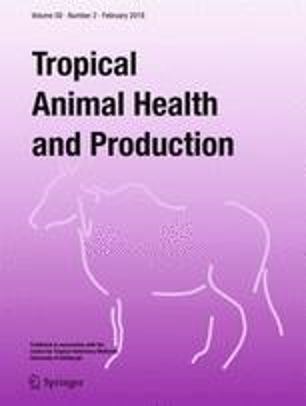Ver ítem
- xmlui.general.dspace_homeCentros e Institutos de InvestigaciónCIAP. Centro de Investigaciones AgropecuariasInstituto de Investigación Animal del Chaco SemiáridoArtículos científicosxmlui.ArtifactBrowser.ItemViewer.trail
- Inicio
- Centros e Institutos de Investigación
- CIAP. Centro de Investigaciones Agropecuarias
- Instituto de Investigación Animal del Chaco Semiárido
- Artículos científicos
- Ver ítem
Effect of gastrointestinal nematodes on serum copper and phosphorus of growing beef calves in northwestern Argentina
Resumen
The aim of this work was to study the effect of gastrointestinal nematodes (GINs) on copper (Cu) and phosphorus (P) in blood of beef cattle in two ranches (R1 and R2) located in northwestern Argentina. In 2015–2016 (R1) and 2016–2017 (R2), in each ranch, 22 weaned female calves were divided into two groups: calves treated systematically with 200 mcg/kg moxidectin every 45–50 days (TG) and untreated calves (UTG). The following parameters were measured:
[ver mas...]
The aim of this work was to study the effect of gastrointestinal nematodes (GINs) on copper (Cu) and phosphorus (P) in blood of beef cattle in two ranches (R1 and R2) located in northwestern Argentina. In 2015–2016 (R1) and 2016–2017 (R2), in each ranch, 22 weaned female calves were divided into two groups: calves treated systematically with 200 mcg/kg moxidectin every 45–50 days (TG) and untreated calves (UTG). The following parameters were measured: number of fecal eggs (epg), fecal cultures, serum Cu and P levels, and live weight gain (LWG). Differences between groups were compared using analysis of variance and Tukey test. GIN infections in both ranches were subclinical and moderate, showing the highest epg (R1 = 907 ± 754; R2 = 1049 ± 1040) by mid-winter. Epg values of TG groups were always negligible (> 93% of moxidectin efficacy). The dominant nematode genera were Cooperia and Haemonchus. The average serum Cu values (μg/dl) indicated low (R1 = 49.7 ± 18) and severe (R2 = 27.2 ± 14) deficiency. The effect of treatments was evident in both ranches from late winter, with TG showing significantly (p < 0.01) higher serum levels in winter, spring, and early autumn (R1 = 65.1, 50.9, and 60.3; R2 = 48.0, 25.7, and 22.4) than UTG (R1 = 44.3, 33.9, and 32.9; R2 = 25.5, 18.2, and 16.4). There were no differences in serum P levels between groups. LWG of TG increased significantly (p < 0.008) (27.2% in R1 and 38.6% in R2), with respect to those of UTG. This study showed a negative effect of GIN on serum Cu values in moderately infected growing calves.
[Cerrar]

Autor
Suarez, Victor Humberto;
Micheloud, Juan Francisco;
Araoz, Virginia;
Martinez, Gabriela Marcela;
Rosa, Diana Esther;
Mattioli, Guillermo Alberto;
Fuente
Tropical animal health and production 51 (3) : 613–618 (March 2019)
Fecha
2018-10
Editorial
Springer
ISSN
0049-4747
1573-7438 (Online)
1573-7438 (Online)
Formato
pdf
Tipo de documento
artículo
Palabras Claves
Derechos de acceso
Restringido
 Excepto donde se diga explicitamente, este item se publica bajo la siguiente descripción: Creative Commons Attribution-NonCommercial-ShareAlike 2.5 Unported (CC BY-NC-SA 2.5)
Excepto donde se diga explicitamente, este item se publica bajo la siguiente descripción: Creative Commons Attribution-NonCommercial-ShareAlike 2.5 Unported (CC BY-NC-SA 2.5)

